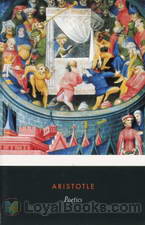|
Books Should Be Free Loyal Books Free Public Domain Audiobooks & eBook Downloads |
|
|
Books Should Be Free Loyal Books Free Public Domain Audiobooks & eBook Downloads |
|
Top Authors |
|---|
|
Book type:
Sort by:
|
By: Aristotle (384-322 BC) | |
|---|---|
 Poetics
Poetics
Aristotle’s Poetics from the 4th century B.C. aims to give a short study of storytelling. It discusses things like unity of plot, reversal of situation, and character in the context of Greek tragedy, comedy and epic poetry. But it still applies today. It is especially popular with screenwriters as seen in many script gurus’ how-to books. | |
By: Nathaniel Hawthorne (1804-1864) | |
|---|---|
 The Scarlet Letter
The Scarlet Letter
A beautiful woman who is punished for the mortal sin of loving a man other than her husband, a cowardly lover, a vengeful husband, a rebellious illegitimate child and the oppressive and patriarchal morality of 17th century Puritanism in Boston. Together these form an unforgettable and thought-provoking glimpse of how much social attitudes have changed over the centuries. Nathaniel Hawthorne was the creator of such beloved works as Twice-Told Tales, A Wonder Book for Boys and Girls, The House of the Seven Gables and spine-chilling tales like Roger Malvin's Burial... | |
 Tanglewood Tales
Tanglewood Tales
A sequel to Nathaniel Hawthorne's earlier volume of Greek mythology interpreted and retold for young people, Tanglewood Tales includes more legends and tales of ancient heroes and monsters. In his earlier book, A Wonder-Book for Girls and Boys, Hawthorne had designed the book to be a book within a book. A young college student keeps a group of young children entertained by retelling Greek myths in a way in which they can easily understand. Nathaniel Hawthorne also wrote a brief introduction to Tanglewood Tales, entitled The Wayside... | |
 The House of the Seven Gables
The House of the Seven Gables
“The wrongdoing of one generation lives into the successive ones and… becomes a pure and uncontrollable mischief.” Hawthorne’s moral for “The House of the Seven Gables,” taken from the Preface, accurately presages his story. The full weight of the gloomy mansion of the title seems to sit on the fortunes of the Pyncheon family. An ancestor took advantage of the Salem witch trials to wrest away the land whereon the house would be raised… but the land’s owner, about to be executed as a wizard, cursed the Pyncheon family until such time as they should make restitution... | |
 The Blithedale Romance
The Blithedale Romance
The Blithedale Romance is the story of four principal characters who work with -- and sometimes against -- each other on Blithedale, a communal farm antecedent to those that sprang up later in the 1960s, and similar to one on which Hawthorne himself lived in 1841. These communes arose out of the pressures on society and the individual brought by the Industrial Revolution. Some were organized around religious philosophies, some were secular. Among the secularists, the Transcendental movement mentioned in the novel espoused the idea that the individual's intuition, rather than religious dogma, was the true path to spiritual enlightenment... | |
 The Great Stone Face and Other Tales of the White Mountains
The Great Stone Face and Other Tales of the White Mountains
A collection of four short stories by Nathaniel Hawthorne, the common theme of which is New Hampshire's White Mountains. Consists of: The Great Stone Face, written in 1850 and revolves around the 'Old Man of the Mountain (Cannon Mtn.) in New Hampshire which sadly collapsed on May 3, 2003; The Ambitious Guest, written in 1835; The Great Carbuncle, written in 1837; and Sketches From Memory, written sometime prior to The Great Carbuncle as will become obvious. | |
 The Marble Faun
The Marble Faun
The Marble Faun is Hawthorne's most unusual romance. Writing on the eve of the American Civil War, Hawthorne set his story in a fantastical Italy. The romance mixes elements of a fable, pastoral, gothic novel, and travel guide. In the spring of 1858, Hawthorne was inspired to write his romance when he saw the Faun of Praxiteles in a Roman sculpture gallery. The theme, characteristic of Hawthorne, is guilt and the Fall of Man. The four main characters are Miriam, a beautiful painter who is compared... | |
 The Great English Short-Story Writers, Volume 1
The Great English Short-Story Writers, Volume 1
| |
 Mosses from an Old Manse and other stories
Mosses from an Old Manse and other stories
| |
 From Twice Told Tales
From Twice Told Tales
| |
 True Stories from History and Biography
True Stories from History and Biography
In writing this ponderous tome, the author's desire has been to describe the eminent characters and remarkable events of our annals, in such a form and style, that the YOUNG might make acquaintance with them of their own accord. For this purpose, while ostensibly relating the adventures of a Chair, he has endeavored to keep a distinct and unbroken thread of authentic history. The Chair is made to pass from one to another of those personages, of whom he thought it most desirable for the young reader to have vivid and familiar ideas, and whose lives and actions would best enable him to give picturesque sketches of the times... | |
 Wonder Book for Girls and Boys
Wonder Book for Girls and Boys
A Yankee student stays at a country house called Tanglewood during a golden New England fall. Also at the house are about a dozen children: younger cousins of the student and their friends of varying ages. The student, as much to amuse himself as to amuse the children, organises games and activities and tells stories. And the stories he tells are wild and fantastic. When his store of fairy tales and folk legends is exhausted he hits on the idea of retelling Greek Myths in his own style.We visit Tanglewood... | |
 The Snow Image and other stories
The Snow Image and other stories
| |
 John Inglefield's Thanksgiving (From: "The Snow Image and Other Twice-Told Tales")
John Inglefield's Thanksgiving (From: "The Snow Image and Other Twice-Told Tales")
| |
 Grandfather's Chair
Grandfather's Chair
| |
 The Snow-Image A Childish Miracle
The Snow-Image A Childish Miracle
| |
 A Wonder Book and Tanglewood Tales For girls and boys
A Wonder Book and Tanglewood Tales For girls and boys
| |
 The Three Golden Apples (From: "A Wonder-Book for Girls and Boys")
The Three Golden Apples (From: "A Wonder-Book for Girls and Boys")
| |
 Earth's Holocaust (From "Mosses from an Old Manse")
Earth's Holocaust (From "Mosses from an Old Manse")
| |
 Passages from the American Notebooks, Volume 1
Passages from the American Notebooks, Volume 1
| |
 Fanshawe
Fanshawe
| |
 The Old Manse (From "Mosses from an Old Manse")
The Old Manse (From "Mosses from an Old Manse")
| |
 The Wives of the Dead (From: "The Snow Image and Other Twice-Told Tales")
The Wives of the Dead (From: "The Snow Image and Other Twice-Told Tales")
| |
 The Paradise of Children (From: "A Wonder-Book for Girls and Boys")
The Paradise of Children (From: "A Wonder-Book for Girls and Boys")
| |
 The Christmas Banquet (From "Mosses from an Old Manse")
The Christmas Banquet (From "Mosses from an Old Manse")
| |
 The Gorgon's Head (From: "A Wonder-Book for Girls and Boys")
The Gorgon's Head (From: "A Wonder-Book for Girls and Boys")
| |